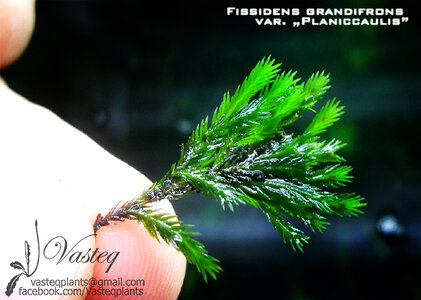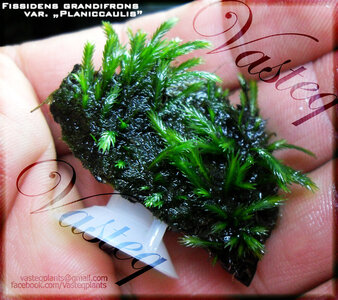Hi Tomasz,
I haven't yet cultivated it, but I also think it's a very remarkable Fissidens.
Maybe this one, traded as "var. Planiccaulis" (imported from Asia?), is not different from other F. grandifrons as it occurs e.g. in Europe. The species was already presented in this thread:
moose-amp-farne/fissidens-grandifrons-t10273.html
Further below in the thread photos of F. grandifrons found in Switzerland.
The name addition "var. Planiccaulis" is apparently derived from the variety name F. grandifrons var. planicaulis. In "Flora of China" this variety is not accepted but treated as a synonym of the species, F. grandifrons.
http://www.efloras.org/florataxon.aspx?flora_id=4&taxon_id=200001058
Fissidens grandifrons has an astonishingly wide distribution: Asia, Europe, Africa, North America. Typical of flowing waters with limestone ground. So it should tolerate high KH also in aquariums. Do your experiences with this moss confirm that?
Gruß
Heiko
(Übersetzung:
Ich habe es noch nicht kultiviert, aber ich denke auch, dass es ein sehr bemerkeswertes Fissidens ist.
Vielleicht ist dieses, das als "var. Planiccaulis" (aus Asien importiert?) gehandel wird, nicht verschieden von anderem F. grandifrons, wie es z.B. in Europa vorkommt. Die Art wurde bereits in diesem Thread vorgestellt:
moose-amp-farne/fissidens-grandifrons-t10273.html
Weiter unten im Thread Fotos von F. grandifrons aus der Schweiz.
Der Namenszusatz "var. Planiccaulis" ist offenbar vom Varietäten-Namen F. grandifrons var. planicaulis abgeleitet. In "Flora of China" wird diese Varietät nicht akzeptiert, sondern mit der Art F. grandifrons synonymisiert.
http://www.efloras.org/florataxon.aspx?flora_id=4&taxon_id=200001058
Fissidens grandifrons hat eine erstaunlich weite Verbreitung: Asien, Europa, Afrika, Nordamerika. Typisch für fließende Gewässer mit Kalkstein-Untergrund. Als sollte die Art auch im Aquarium eine hohe KH vertragen. Hast du mit diesem Moos bereits Erfahrungen gemacht, die darauf hindeuten?)




